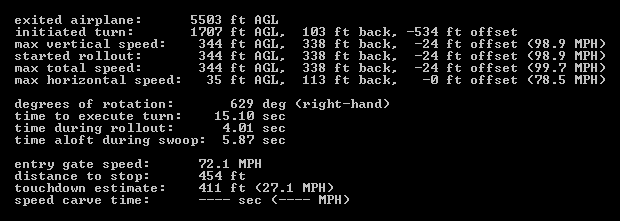exited airplane:
This is a very precise indication of exit altitude. If you exit while the
plane is climbing (which is typical during a hop-n-pop) you will be "thrown"
upward but the GPS can detect the precise exit point based on downward
acceleration.
initiated turn:
This indicates the initiation altitude of the speed building maneuver.
This may mean different things depending on the pilot's flying style.
It is typically the point where the pilot released his brakes and began
applying double front riser input.
max vertical speed:
This is the highest vertical speed during the turn (it usually occurs right
before the rollout). It is a good indicator of how much power was built in
the turn (wind has little effect on this metric).
started rollout:
This is the altitude where the rollout begins. It is defined as the point
where vertical speed peaks and then monotonically decreases until ground
level. You may still be turning during the rollout but you are not
generating vertical speed. Usually only minor heading corrections occur
during the rollout.
max total speed:
This is the highest total speed (combined speed on all axes) during the
turn. Wind will influence this value.
max horizontal speed:
This is the highest horizontal speed (combined speed in the x-axis and
y-axis) during the turn and rollout. Wind will strongly influence this
value (it will be higher during downwind swoops and lower during upwind
swoops).
degrees of rotation:
This indicates the size of the turn (the total heading change during the
speed building maneuver).
time to execute turn:
This is the elapsed time between the start of the turn and the beginning
of the rollout.
time during rollout:
This is the elapsed time between the start of the rollout and the point
where the pilot passes the entry gate. If the entry gate is missed no
value will be computed.
time aloft during swoop:
This is the elapsed time between the entry gate and touchdown.
entry gate speed:
This is the x-axis speed when the pilot eclipses the entry gate. It is
interpolated between the nearest points before and after the gate.
distance to stop:
This is the x-axis distance between the entry gate and the point where
motion stops (it includes the slide or runout).
touchdown estimate:
This is an estimate of the x-axis distance between the entry gate and the
first point of contact with the ground. The pilot must walk back to the
touchdown point before turning off the GPS in order to calculate this metric.
speed carve time:
This is the time elapsed during a speed run through an IPC speed carve
course. It is calculated only if the heuristics detect a speed carve run.
